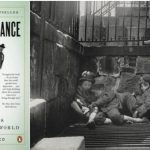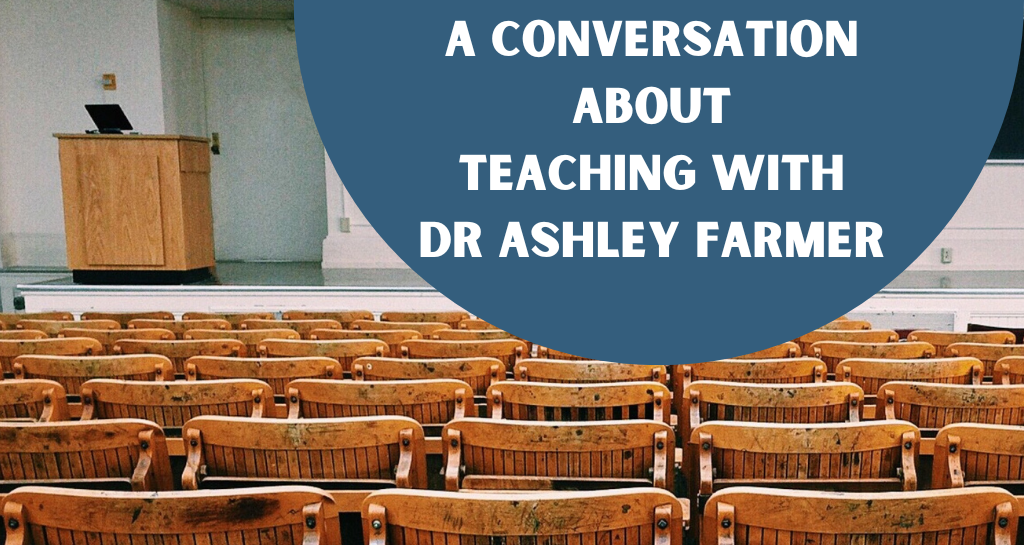
From the editor: Not Even Past Teaching Profiles are designed to explore how historians at the University of Texas and beyond teach, how they inspire and galvanize students. In this article, we speak with Dr Ashley Farmer. Dr Farmer has a remarkable record of achievement in the classroom. She won the 2020 Faculty Teaching Award from the John L. Warfield Center for African & African American Studies, the 2020 Josefina Paredes Endowed Teaching Award from the College of Liberal Arts and the 2019 Jean Holloway Award for Excellence in Teaching from Texas Exes. She was also nominated for the Lucia, John and Melissa Gilbert Teaching Excellence Award in Women’s and Gender Studies and was a semi-finalist for the Friar’s Centennial Teaching Award Fellowship. This conversation was recorded in 2020 at the height of the pandemic but we are republishing it now to mark another milestone for Dr Farmer. In 2023, the Academy of Distinguished Teachers recognized Ashley Farmer for her exceptional record of teaching excellence and invited her to become a member.
As part of this conversation, I was able to read some of Dr Farmer’s syllabi and classroom materials. They speak to a classroom that engages, excites and transforms students, making them better citizens and giving them new ways to understand the world. Most moving is a video included below in which one of Dr Farmer’s student’s speaks to their experience as a freshman in one of her classes. Such teaching requires enormous commitments of time and energy. In addition to showcasing incredible teachers, my hope is that such teaching profiles will also provide a resource for other teachers thinking about specific classroom strategies and the discussion below focuses particular attention on a series of unique activities and exercises that Dr Farmer has developed for use in the classroom.
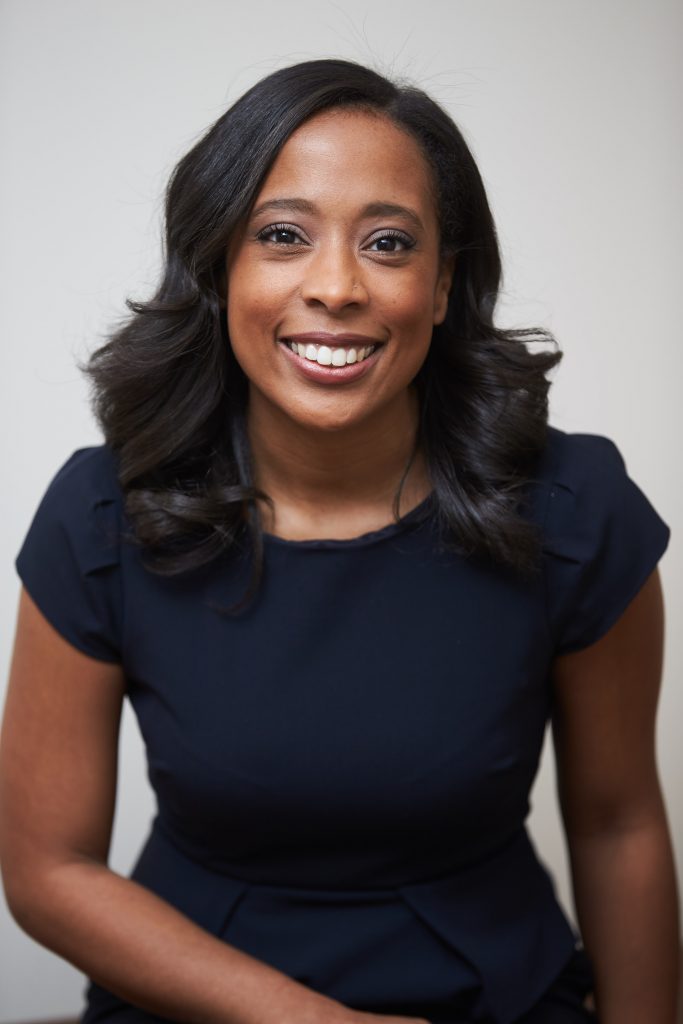
AC: Alongside your groundbreaking research, you’ve won a range of teaching awards and I don’t think I’ve ever seen quite such a record of achievement in the classroom in a relatively short space of time. What classes and academic experiences shaped you as teacher?
AF: I know this is going to sound a little funny, but I was a Montessori school kid for many years. I didn’t just go to preschool, but I went through a good chunk of grade school as a Montessori student. And I bring this up because one of the things that Montessori pedagogy focuses on is experiential learning, tactile learning, and also this idea that if we trust students, they’ll do what they need to do and can be in control of organizing their own lives and how they want to learn. And so I think that that had a more profound effect on me than I realize now that I am a teacher, just that ethos about letting students explore; the ethos about saying here’s a collection of things we have to do, but we don’t have to do them in one particular way, but here’s some concepts that we’re going to explore together. I think that was really useful.
And going to a historically Black college like Spelman. It was small. The entire curriculum was not just Black centered, but Black women centered. So, for example, I was a French and Spanish major in college, which is different from what I do now but the point is, that instead of learning French history, we would take classes like Francophone literature of North Africa, right. We would read novels about the Black experience that happen to be in French. So you’re learning the language and the writing, but also thinking about the Black experience that way. And I think that was just really formative for reminding me that we don’t always have to engage in learning in the dominant modes in which it’s expected or in a certain kind of curriculum that often marginalizes certain types of people.
AC: Our conversation today will focus on your course, Introduction to African American History. Can you introduce that course to someone who’s not familiar with it?
AF: So Introduction African American history is an entry level course for anyone interested in learning more about the Black experience in America. It goes from the 1400s to the present so it’s very quick in 16 weeks. I often call it an odyssey because we’re hopping from one point to the next very quickly. But it is meant to not only give students a basic understanding of Black history, but also to get them to think about how this history is shaping the world around them. So I often ask students to think less about regurgitating points and dates like when was the Civil War? Or, what was the 13th Amendment? Instead, I ask my students to think about what the 13th Amendment meant for everyday Black people or what life choices did Black people have to make based on the options that were given to them in a certain historical moment. The course has a cultural diversity flag and also a History core credit flag so I get a range of students from freshman to seniors who take the class.
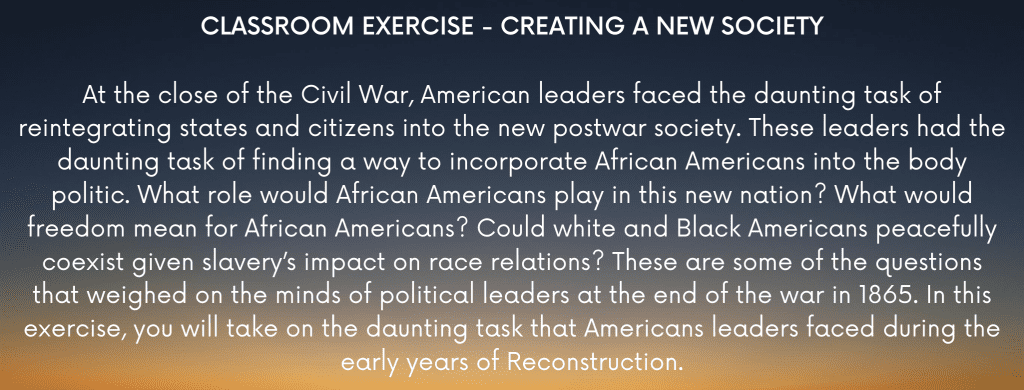
AC: This course includes a range of highly innovative and effective class exercises. I was struck especially by the classroom activity, “Creating a New Society”. Can you tell us about this exercise?
AC: This is a large lecture class but you don’t start each class by lecturing. Instead you write that you cede “the floor for the first five minutes of class to a student who wants to raise an issue about campus, Austin, or the national climate.” Can you tell us more about this?
AF: I like to always get to the classroom a little bit before class starts. I set everything up and then we just kind of talk informally as a class. I ask what’s going on campus? Or if they saw a certain topic in the news? To give an example around Halloween time, we talked about costumes. I know students are aware of conversations about racism, sexism, and cultural appropriation around costumes, so I will say something along the lines of: did you see this costume I saw online? Does anybody know what’s happening with costumes on UT’s campus? And usually that will allow for someone to speak up about something that they have been thinking about.
I start that way at the beginning of the semester and I find it by mid semester students come in with something they want to talk about. One day, I arrived a bit late, so I didn’t get to do this. And I had one student stop me and say: “What are we talking about today? Because we always talk about stuff before we get started. So what’s our topic today?” They wanted me to go back and do our informal discussion first before we got started with our lesson plan for the day. It made me laugh, but also showed me that they value these conversations that we have together. I think beginning class this way is important for a couple of reasons. Typically, students bring up things that are happening in the world that are related to class. We learned about something, say, the prison industrial complex in class. Students will then bring up an article they have seen about prisons in Texas. Or, we talk about the historical context of policing and then students will want to talk about the school’s relationship to policing or something like that. So these conversations help students connect what’s happening in the classroom to the real world. Also, in the spirit of consciousness raising, it also shows students that I believe that I’m not the only person in the room that can offer valuable information or perspectives or who has something to teach or raise awareness about. We all can contribute to helping each other understand what’s happening on our campus, in the world, around us. And truth be told, because the students live and work and learn on the campus in a way that faculty members don’t, this is honestly where I get a lot of my news about what is happening on campus. So it’s mutually beneficial
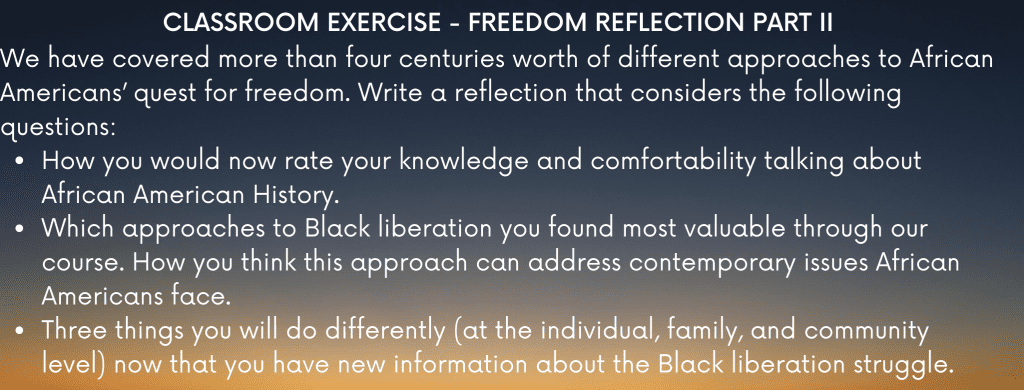
Classroom exercise from Introduction to African American History
AC: Another exercise I was really struck by is the “Freedom Reflection Exercise”? Can you describe this exercise and what it aims to achieve?
AC: What it like to be teaching this course in this moment when the national conversation about race is being transformed by Black Lives Matter?
AF: You know, it makes our conversations feel very urgent. All of a sudden, things are happening both locally and nationally that really clues students in, if they haven’t been engaging before in these conversations, that something’s not right. And they need to know more. I don’t think many people have a hard time understanding how watching the George Floyd murder is something that is heartbreaking and tragic. It should not happen. It happens disproportionately to Black people. But then when you start to learn about how it’s not an isolated incident, you’re in search of ways to understand something so difficult, in search of a kind of language or lens to understand it. Students are often thinking: I know something unjust has happened and continues to happen. How did we get here? How do I talk about it and how do I possibly do something about it in a responsible way? And that’s what I see as a history class like this doing. It is helping people get the language or the framework to understand the world around them and take different actions. So I will say that even though I’m not teaching this particular class this year, I have had at least 10 emails from students who have taken the class over the last couple of years. In the emails they say that they remember when we talked about these issues in class, and now they understand how that’s coming in to play. They tell me that they remember when we talked about the Voting Rights Act and voter suppression and how that is playing out in society now. So I do think that this is a part of education that can really meet the moment we are in.
AC: There is a remarkable video of a student who has nominated you for a major teaching prize explaining their transformative experience in one of your classes. I think it speaks to exactly what you’re saying about how teaching can meet the moment we’re in. Can you tell us about that particular class?
AF: For that class, we were in a midterm election year. And I planned for us to talk about the Voting Rights Act on the same week that the election was happening, to draw the connection between the class and larger society very clearly. I told them when you have learned about people getting beat within an inch of their life and people getting shot, people losing their jobs, how dare you not go literally 50 feet to the library and cast a vote? And I said it in those terms: you cannot take this so lightly. And I think that that is important because we’re now teaching students who have become politically literate and electorally literate in a moment where a Black man or a woman president or vice president are all possible, which for most of us, was perhaps something that we thought would never happen. And I think that sometimes this can lull people into a sense of complacency about the security of our electoral system and the democratic process. So I try to draw a clear line for them between struggles of the recent past and today. I think this is contextualization that can really help prepare students to understand this moment.
One of Dr Farmer’s students describes their experience as a freshman in one of her classes
AC: For a class like Introduction to African American History, you cover some very difficult and traumatic topics. For example, you discuss lynching as a form of racial and sexual terror. Can you tell us how you approach this and how you create an environment in which you’re able to respect and honor the victims of these crimes while engaging the students as historians?
AF: I start out by saying: We’re going to look at some really, really difficult things and everybody is going to have a really different reaction to them because we all have a different relationship to heinous act. But it is not something that we can turn away from. It’s not something that we cannot discuss if we are going to try to make ourselves understand the Black experience in America. So our job here is to figure out how as a community we want to do that. One of the ways I do this is by starting with just a few pictures of lynchings. And I ask students to work together with each other, usually just with the person sitting next to them, to think about their initial emotional response to these images. I ask them to think about the images and how they want to talk about them. I ask them to consider what language they want to use to honor these victims and what our role as historians is in documenting and talking about lynching. I treat the students like they’re historians, you know, in the professional sense in talking about this in a way that doesn’t let the perpetrators off the hook. I have students collectively come up with a set of community rules about how we should talk about lynching in an honest and respectful way. I put them on the board and say this is how we have decided how to talk about this topic as a group. And then we move forward with our discussion with these rules in mind.
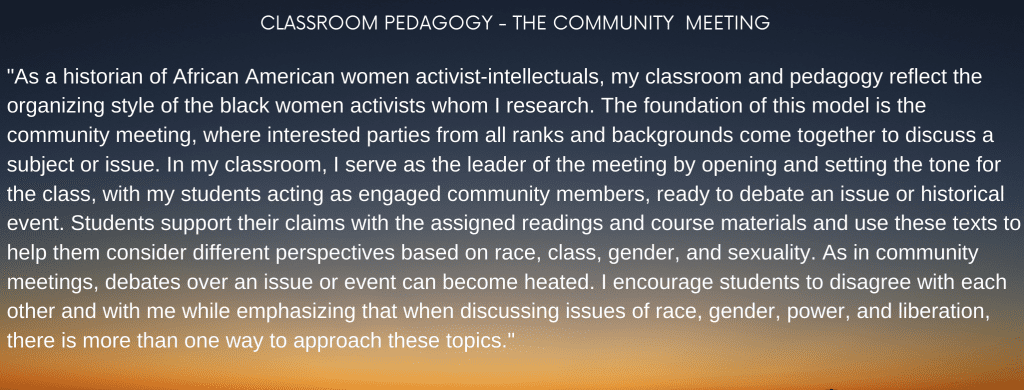
AC: : What I found most fascinating and effective is the ways in which your research and teaching intersect and speak to each other. Key to this is your classroom pedagogy, where you model your approach after the community meeting “where interested parties from all ranks and backgrounds come together to discuss a subject or issue”. Can you tell us more about this?
Thank you so much for talking to me and for sharing some of the teaching strategies, methods and approaches you use in the classroom.



